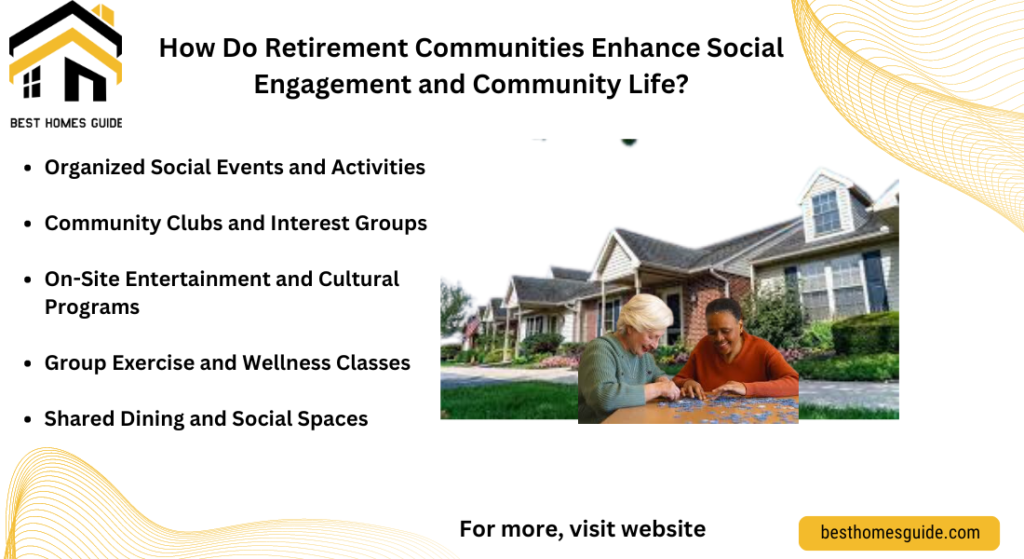As individuals approach their golden years, the choice of where to live becomes increasingly significant. Retirement communities offer a range of options designed to meet the diverse needs and preferences of seniors. These specialized living environments are tailored to provide comfort, security, and a fulfilling lifestyle during retirement. In this article, we’ll explore the essential aspects of retirement communities, including their key features, benefits, and how they compare to other living arrangements. Whether you’re considering moving to a retirement community or helping a loved one make this important decision, what these communities offer can help ensure a smooth transition and a satisfying retirement experience.
Senior living, Retirement living options, Active adult communities, Independent living, Senior housing, Retirement village, Elderly care, Senior residences, Age-friendly communities, Retirement home amenities.
How Do Retirement Communities Compare to Independent Living Options?
Retirement communities and independent living options both provide a supportive environment for seniors, but they cater to different needs and preferences. Retirement communities offer a range of services and amenities designed specifically for retirees, including organized social activities, wellness programs, and on-site healthcare services. They often have different levels of care available, from independent living to assisted living and memory care, allowing for a continuum of care as needs change.
Independent living options focus primarily on providing a self-sufficient lifestyle with minimal support. These settings usually offer fewer services and amenities compared to retirement communities, emphasizing personal autonomy and freedom. While they may offer some community features, such as social events and basic maintenance, they lack the comprehensive care and support systems found in most retirement communities.
What Benefits Do Residents Gain from Living in a Retirement Community?
Residents of retirement communities enjoy numerous benefits that enhance their quality of life and well-being. The primary advantages is the opportunity to engage in a vibrant community life. These communities often offer a variety of social activities, fitness programs, and educational opportunities, which help residents stay active, socially connected, and mentally engaged. This active lifestyle can significantly improve overall health and happiness.
Retirement communities provide a sense of security and convenience. On-site services such as maintenance, housekeeping, and sometimes even medical care alleviate many of the daily burdens of homeownership. This comprehensive support system ensures that residents can focus on enjoying their retirement without the stress of managing a household or handling emergencies on their own.
How Can Evaluate the Best Retirement Community for Needs?
Choosing the right retirement community involves careful consideration of several factors to ensure it meets your personal needs and preferences. Start by assessing the communities location, And proximity to family, friends, and essential services can be critical. Evaluate the range of amenities and services offered, including dining options, recreational facilities, and healthcare services. It is important to select a community that aligns with your lifestyle and provides the level of care you anticipate needing.
A key consideration is the communities reputation and the experiences of current residents. Visiting potential communities and speaking with residents can provide valuable insights into the daily life and overall satisfaction within the community. Reviewing the communities financial stability and the costs involved will help ensure that the chosen option is both affordable and sustainable in the long term.

What Are the Financial Considerations When Choosing a Retirement Community?
When selecting a retirement community, the financial aspects is crucial to ensuring that it fits within your budget and long-term financial plans. Retirement communities often have various pricing structures, including one-time entrance fees and monthly service charges. Entrance fees can be substantial and may vary based on the size of the unit and the level of care provided. These fees might also offer different financial models, such as refundable or non-refundable options, which should be carefully reviewed.
Monthly service charges cover costs for amenities, maintenance, and sometimes healthcare services. It is important to examine what is included in these charges and if there are additional costs for services such as transportation, dining, or personal care. the full financial commitment will help in making an informed decision and avoiding unexpected expenses in the future. Consulting with a financial advisor familiar with retirement planning can also provide valuable guidance in evaluating different community options.
How Do Retirement Communities Address Healthcare and Medical Needs?
Healthcare and medical support are critical considerations in retirement communities, as these communities often serve individuals with varying health needs. Many retirement communities offer on-site medical services or have partnerships with local healthcare providers. This can include regular health check-ups, emergency response services, and access to specialized care, ensuring that residents receive timely and appropriate medical attention. And provided facilities of Real Estate Data analytics for better Decisions.
Some communities provide different levels of care based on the residents’ needs, such as assisted living or memory care units. These levels of care are designed to support individuals who may require additional help with daily activities or have specific medical conditions. It is important to assess the healthcare services available and their alignment with your health needs or those of your loved ones. A community that integrates healthcare services seamlessly with its residential offerings can significantly enhance the quality of life and peace of mind for residents and their families.
What Social and Recreational Activities Are Typically Offered in Retirement Communities?
Social and recreational activities are a hallmark of retirement communities, designed to promote an active and engaging lifestyle. These communities often feature a wide range of activities, from fitness classes and arts and crafts to educational workshops and social gatherings. Regular events and programs are organized to encourage interaction among residents and foster a sense of community.
Recreational facilities such as swimming pools, golf courses, and clubhouses are commonly available, providing opportunities for physical exercise and leisure. Many communities also offer organized outings and excursions, allowing residents to explore new interests and maintain an active social life. By providing diverse activities, retirement communities help residents stay engaged, physically fit, and emotionally fulfilled, contributing to their well-being and satisfaction.
How Do Retirement Communities Ensure Safety and Accessibility for Residents?
Safety and accessibility are paramount in retirement communities, as these aspects significantly impact the quality of life for residents. Most retirement communities are designed with features that enhance safety, such as well-lit pathways, emergency call systems, and secure entry points. Many communities have staff trained to respond to emergencies, providing an added layer of security for residents.
Accessibility is also a key consideration, with many communities incorporating universal design principles to accommodate residents with mobility challenges. This includes features like wheelchair-accessible entrances, grab bars in bathrooms, and elevators in multi-story buildings. Ensuring that these features are in place helps create an environment where residents can navigate their living spaces comfortably and safely, promoting independence and peace of mind.

What Are the Trends and Innovations Shaping Retirement Communities in 2024?
As retirement communities evolve, several trends and innovations are shaping the future of senior living. A major trend is the integration of technology to enhance convenience and connectivity. Smart home features, such as automated lighting, temperature controls, and health monitoring systems, are becoming, allowing residents to manage their environment more easily and stay connected with family and healthcare providers.
A significant trend is the focus on wellness and holistic health. Many retirement communities are incorporating wellness centers that offer fitness classes, mental health services, and nutrition counselling. There is an increasing emphasis on creating environments that support an active and socially engaged lifestyle, with amenities like community gardens, hobby workshops, and lifelong learning programs. These innovations are designed to improve well-being and provide a richer, more fulfilling retirement experience. All these Provided in smart home with Technology Trend.
How Can Families Support Loved Ones in Transitioning to a Retirement Community?
Transitioning to a retirement community can be a significant adjustment for seniors and their families. Families play a crucial role in supporting this transition by providing emotional support and practical assistance. Open and honest communication about the reasons for the move, the benefits of the new environment, and the expectations can help alleviate anxiety and resistance.
Involving loved ones in the decision-making process and visiting potential communities together can make the transition smoother. It is helpful to assist with organizing the move, including sorting belongings and setting up the new living space to make it feel familiar and comfortable. Providing ongoing encouragement and staying engaged with the community through regular visits and involvement in activities can help ease the adjustment and foster a positive experience in the new environment.
What Are the Key Features of Modern Retirement Communities?
Modern retirement communities are designed to offer a blend of comfort, convenience, and engagement for seniors. The key features is the variety of living arrangements available, including independent living apartments, assisted living units, and memory care facilities. These options provide flexibility to meet different levels of care and personal preferences, allowing residents to transition smoothly as their needs change.
A significant feature is the range of amenities and services provided. Many modern retirement communities include state-of-the-art fitness centers, wellness programs, and recreational facilities such as swimming pools, golf courses, and community gardens. Social and cultural activities are also a staple, with organized events like lectures, arts and crafts classes, and group outings designed to keep residents active and socially engaged. These features collectively enhance the quality of life and foster a vibrant, supportive community environment.
How Do Retirement Communities Enhance Social Engagement and Community Life?
Social engagement and community life are central to the appeal of retirement communities. These communities are designed to foster a sense of belonging and connection among residents through a variety of social activities and programs. Regular events such as themed parties, game nights, and group outings encourage interaction and help build friendships.
Community spaces like clubhouses, dining areas, and recreational facilities are strategically designed to facilitate socialization. Many communities also offer clubs and interest groups tailored to residents hobbies and passions, such as gardening clubs, book clubs, or fitness groups. And providing numerous opportunities for social interaction and community involvement, retirement communities help combat loneliness and promote a lively, inclusive atmosphere.

How Can You Choose the Right Retirement Community for Your Lifestyle?
Selecting the right retirement community requires careful consideration of various factors to ensure it aligns with your lifestyle and preferences. Start by identifying your priorities, such as the type of care you may need, preferred location, and desired amenities. It is important to visit multiple communities to compare their offerings and get a feel for the environment and culture.
Assess the communities compatibility with your lifestyle by evaluating its activities, social opportunities, and atmosphere. Consider how well the communities services and amenities match your interests and needs. Factor in the financial aspects, including costs and what is included in the monthly fees. Thoroughly researching and visiting different options, you can make an informed choice that enhances your retirement experience and fits well with your personal and financial needs.
What Should You Consider When Choosing a Retirement Community?
Choosing the right retirement community is a decision that can significantly impact your quality of life during retirement. It involves evaluating various factors such as the types of care offered, the range of amenities, and the environment of the community. The financial commitments, including entrance fees and monthly charges, is also essential to ensure that the community fits within your budget.
Consider the level of social engagement and recreational activities available, as these can greatly enhance your lifestyle and well-being. Visiting multiple communities and involving family members in the decision-making process can provide valuable insights and help you find a community that aligns with your personal preferences and needs. Carefully weighing these factors, you can make an informed choice that supports a fulfilling and enjoyable retirement.
When searching for the best retirement communities, it is essential to consider factors like healthcare services, social activities, and accessibility to ensure a fulfilling and comfortable lifestyle. As you explore these communities, keep in mind how modern tools like virtual staging can enhance your experience. Virtual staging allows you to visualize potential living spaces within these communities, making it is easier to find a home that suits your preferences. Combining the insights on the best retirement communities with the benefits of virtual staging, you can make a well-informed decision about your future living environment.
